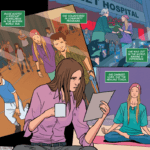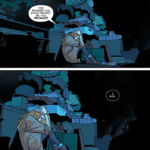When a writer is committed to explore issues like trauma and PTSD, they know they’re in for a long ride. You can’t simply wave away trauma or turn it off like a switch when convenient for the plot. Healing is often a slow and painful process and recovery is not that simple. Trauma changes you. There’s no going back to how things were before, to how you were before, you must find your way forward. Deconstructed, Hulk’s current story arc, knows all this very well.
Hulk #3 picks up where the last issue left us: with Mr. Tick as a meat pudding smashed in the pavement. The police doesn’t know who did it, but Jen Walters correctly guesses that her client Ms. Brewn must be involved somehow. Unfortunately, the inhuman lady is not answering her calls.
When the news mentions the recent superhero Civil War, we’re reminded Jennifer still has a lot of her own issues to deal with. This was enough to almost trigger a Hulk transformation, making her accidentally break her laptop once more.
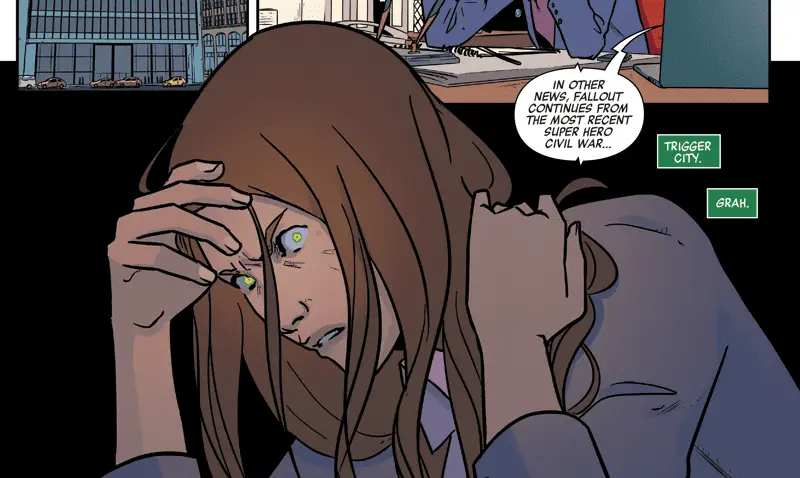
Jennifer tries to go on with her regular working day, until she receives a call from Patsy Walker. Patsy misses her and wants to have a friendly conversation. As Jen notes herself, though, talking with Patsy reminds her of how different she is from the person Patsy knew and how she’s afraid to confront that difference. Jen tries to end the convo, but Hellcat won’t take no for an answer. She shows up in front of Jen, superhero costume and everything.
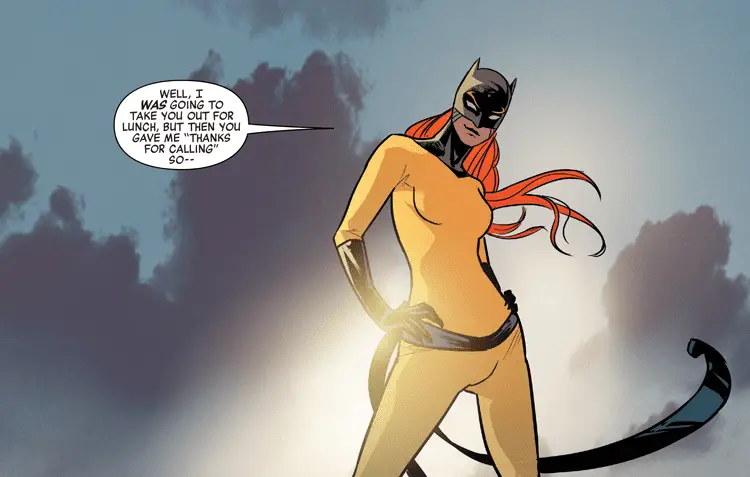
Patsy is upset because they used to be best friends and now Jen is brushing her off. She clearly has good intentions, but there’s an obvious difference in how both women perceive what happened to Jen and how much it affected her. Jen can’t connect to Patsy anymore (or to anyone, really), and Patsy doesn’t understand why. She realizes Jen needs some space, but emphasizes she won’t disappear. Jen’s counting on that. A civilian nearby, excited with the sight of Hellcat, asks Jen if she’s a superhero too, and she answers negatively. It breaks my heart a little bit.
Later, neither Jen nor her assistant Brad can reach Ms. Brewn. Jennifer wonders why she cares so much about this client in particular, but she knows the answer: Ms. Brewn’s experiences mirror her own. Both women almost died under traumatic circumstances that deeply changed them and both feel they’re not who they used to be.
Next, we learn what happened to Ms. Brewn. She was a sunny and serene yoga instructor, trying to make the world a better and more positive place. Until one night she was assaulted and left for dead; her partner wanted to sell the business and hired a few men to murder her. Ms. Brewn was in the hospital during the trial, so she never got to hear her ex-partner testify as to why he would betray her like this.
Meanwhile, the police reach Ms. Brewn. They don’t look especially suspicious of her, but they say they’ll keep in touch and that’s more than she can handle. Once more she asks for the help of whatever is lurking in the shadows of her home… and once more the thing answers her. Police officers are no more.
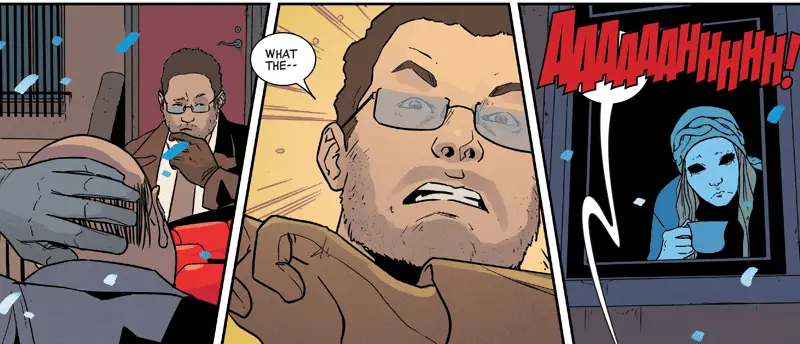
Hulk #3 explores the parallels between Jen and Ms. Brewn. Just as the Hulk came to represent Jen’s trauma, the murderous shadowy creature is apparently a manifestation of Ms. Brewn’s fears. By mirroring their traumas and experiences, the story also paves the way to explore their different approaches and resolutions. I’m excited to see how confronting Ms. Brewn’s monster will reflect in Jen’s confrontation with her own.
Another interesting parallel happens between Jennifer and Patsy. This was the first time we saw Jen interacting with a friend, someone that was already a part of her life before she suffered her trauma conga line. I’m not very familiar with Hellcat’s adventures (Marvel’s Jessica Jones doesn’t count), but I like the choice of having her meet Jen in superhero costume. It creates a contrast between both women, as Patsy in that scene represents everything Jen can’t connect to anymore, from her identity as a superhero to normal conversations with friends. This distance is even reflected in the palette, as Hellcat is the brightest, warmest, and most colorful element in the scene:
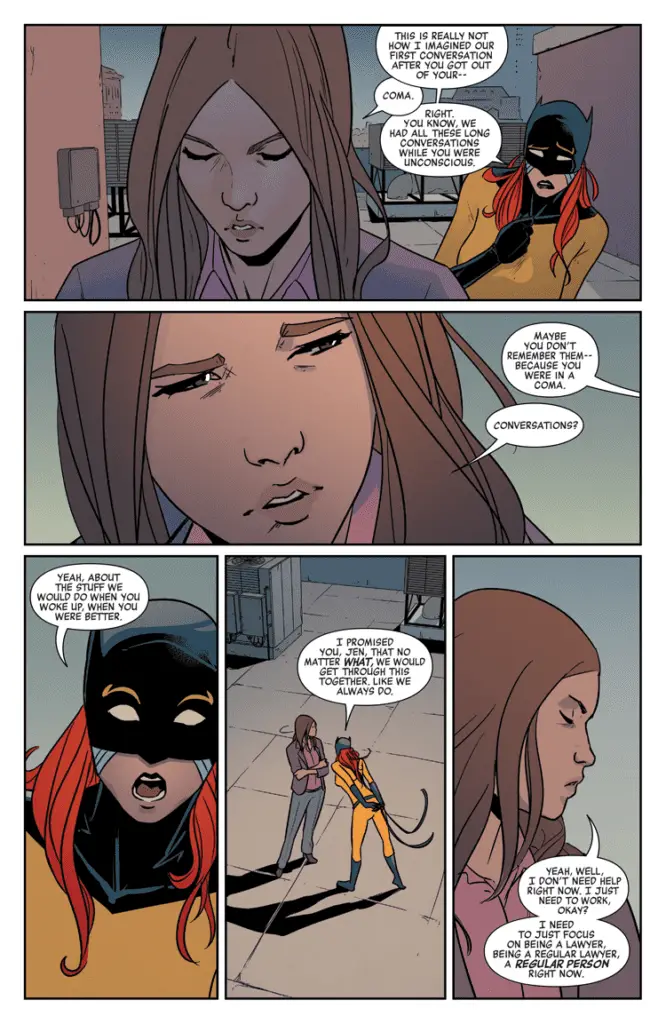 Speaking of palette, once more the colors are amazing and help set the mood for the story. The palettes are carefully chosen: the depressing brown hues of Ms. Brewn’s building, the contrast between Ms. Brewn’s bright and colorful life before the trauma and the blue hues and sharp shadows of her current life…
Speaking of palette, once more the colors are amazing and help set the mood for the story. The palettes are carefully chosen: the depressing brown hues of Ms. Brewn’s building, the contrast between Ms. Brewn’s bright and colorful life before the trauma and the blue hues and sharp shadows of her current life…
[tw_gallery type=”gallery,slider” height=”100″]
[/tw_gallery]
Even the matching palettes of Jen’s and Ms. Brewn’s last panels.
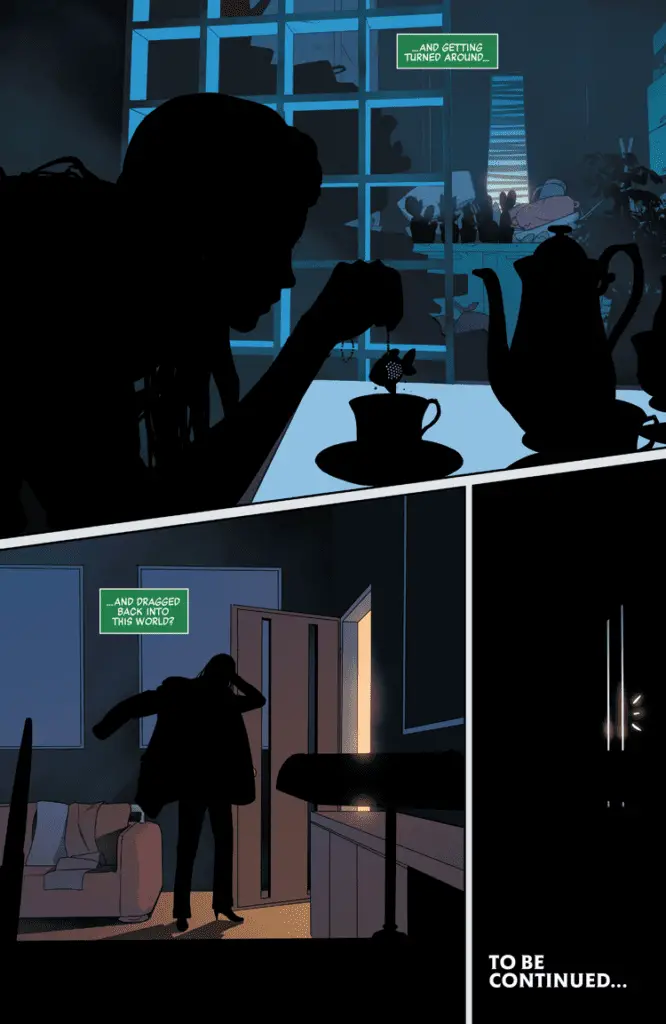
The art is rich and beautiful. The open plans and detailed backgrounds convey the feeling that there’s a whole world happening outside of this story, emphasizing the loneliness of what Jennifer is experiencing and the fact that the world moves on despite what happened to her.
Getting back to a “normal” routine and getting in touch with elements from her pre-trauma life accentuate to Jen how everything has changed. Quoting writer Mariko Tamaki,
“We see Jen kind of isolating herself from everybody right now. Part of this issue, and this series, entails looking [at] how she has specifically separated herself from her friends. She has made a distinction between her old life and her new life, but I see that as a false dichotomy because her old life still exists, those people go on living.”
I’m curious to see how the narrative will handle this dichotomy and Jen’s journey. Jen has to reconnect with her “old life”, symbolized by the Hulk. Yet healing doesn’t mean everything will return to what it was before, as if her trauma hasn’t happened. Comic books are infamous for their impermanence, but I hope Jen’s experiences are not easily forgotten after Tamaki’s captivating story.
It’s worth noting this is the third issue of Hulk without a Hulk transformation. Yet the Hulk is there: in Jennifer’s reflection in the mirror, in her inner monologue, in her eyes when something triggers her. I appreciate that the narrative is taking its time to explore Jennifer’s feelings and the aftermath of her trauma. It’s a slow-paced narrative, because the nature of her experiences demand it to be, but it advances to interesting places.
All images courtesy of Marvel Comics.
Credits for Hulk (2016) #3
Writer: Mariko Tamaki
Artist: Nico Leon
Colors: Matt Milla
Letters: VC’s Cory Petit
Designer: Manny Mederos


